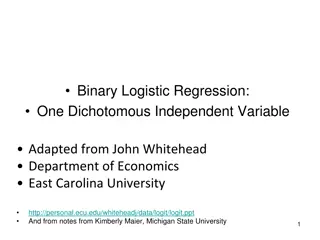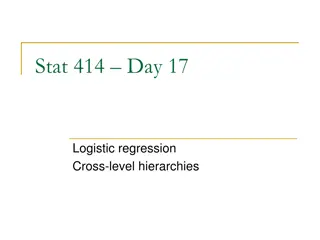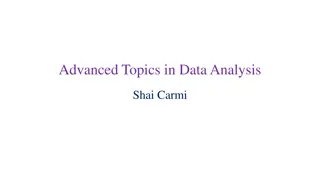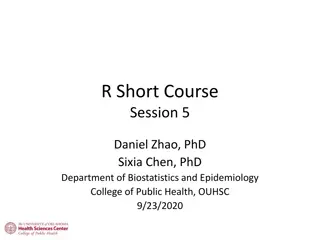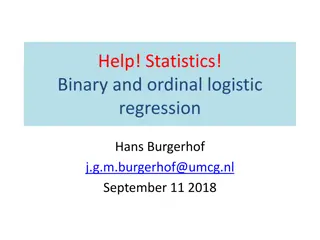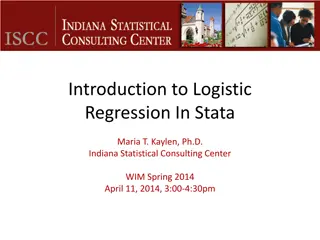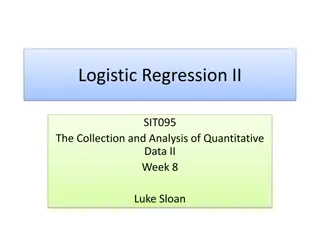Machine Learning Concepts: Linear Classification and Logistic Regression
Explore the fundamentals of machine learning through concepts such as Deterministic Learning, Linear Classification, and Logistic Regression. Gain insights on linear hyperplanes, margin computation, and the uniqueness of functions found in logistic regression. Enhance your understanding of these key
6 views • 62 slides
Binary Logistic Regression with SPSS – A Comprehensive Guide by Karl L. Wuensch
Explore the world of Binary Logistic Regression with SPSS through an instructional document provided by Karl L. Wuensch of East Carolina University. Understand when to use this regression model, its applications in research involving dichotomous variables, and the iterative maximum likelihood proced
2 views • 87 slides
Multivariate Binary Logistic Regression Models: A Practical Example
Exploring the application of multivariate binary logistic regression through an example on factors associated with receiving assistance during childbirth in Ghana. The analysis includes variables such as wealth quintile, number of children, residence, and education level. Results from the regression
1 views • 19 slides
Introduction to Binary Logistic Regression: A Comprehensive Guide
Binary logistic regression is a valuable tool for studying relationships between categorical variables, such as disease presence, voting intentions, and Likert-scale responses. Unlike linear regression, binary logistic regression ensures predicted values lie between 0 and 1, making it suitable for m
9 views • 17 slides
Introduction to Multinomial Logistic Regression by Dr. Heini V. at University of Southampton
This content introduces Multinomial Logistic Regression, discussing categorical response variables, the basics of the model, interpretation of parameters, and an example study on economic activity and gender. It covers the extension of binary logistic regression to multiple categories, interpretatio
2 views • 16 slides
Binary Logistic Regression and Its Importance in Research
Binary logistic regression is an essential statistical technique used in research when the dependent variable is dichotomous, such as yes/no outcomes. It overcomes limitations of linear regression, especially when dealing with non-normally distributed variables. Logistic regression is crucial for an
1 views • 20 slides
Overdispersed Data in SAS for Regression Analysis
Explore the concept of overdispersion in count and binary data, its causes, consequences, and how to account for it in regression analysis using SAS. Learn about Poisson and binomial distributions, along with common techniques like Poisson regression and logistic regression. Gain insights into handl
1 views • 61 slides
Binary Heaps: Efficient Data Structure for Priority Queue Operations
Explore the concept of binary heaps, a specialized type of binary tree that allows for quick retrieval of the smallest (or largest) element. Learn how binary heaps excel in finding the minimum value, essential for priority queue applications in operating systems, event simulations, and more. Compare
2 views • 34 slides
Logistic Regression in Multi-level Hierarchies
Explore the intricacies of logistic regression in cross-level hierarchies through helpful project advice, model graphs, and leftover considerations. Learn about transforming binary responses, interpreting log-odds, and conducting multilevel logistic regression with random intercepts. Dive into real-
1 views • 21 slides
Linear Regression and Gradient Descent
Linear regression is about predicting continuous values, while logistic regression deals with discrete predictions. Gradient descent is a widely used optimization technique in machine learning. To predict commute times for new individuals based on data, we can use linear regression assuming a linear
2 views • 30 slides
Multiclass Logistic Regression in Data Science
Multiclass logistic regression extends standard logistic regression to predict outcomes with more than two categories. It includes ordinal logistic regression for hierarchical categories and multinomial logistic regression for non-ordered categories. By fitting separate models for each category, suc
3 views • 23 slides
Introduction to Advanced Topics in Data Analysis and Machine Learning
This content delves into advanced topics in data analysis and machine learning, covering supervised and unsupervised learning, classification, logistic regression, modeling class probabilities, and prediction using logistic functions. It discusses foundational concepts, training data, classification
0 views • 28 slides
Logistic Growth in Population Dynamics
Explore the logistic growth equation and its applications in modeling population dynamics. Dive into the concept of sigmoidal growth curves and the logistic model, which reflects population growth with limits. Learn how to calculate population change using the logistic growth equation and understand
2 views • 26 slides
R Short Course Session 5 Overview: Linear and Logistic Regression
In this session, Dr. Daniel Zhao and Dr. Sixia Chen from the Department of Biostatistics and Epidemiology at the College of Public Health, OUHSC, cover topics on linear regression including fitting models, checking results, examining normality, outliers, collinearity, model selection, and comparison
0 views • 44 slides
Multivariate Adaptive Regression Splines (MARS) in Machine Learning
Multivariate Adaptive Regression Splines (MARS) offer a flexible approach in machine learning by combining features of linear regression, non-linear regression, and basis expansions. Unlike traditional models, MARS makes no assumptions about the underlying functional relationship, leading to improve
0 views • 42 slides
Introduction to Machine Learning: Model Selection and Error Decomposition
This course covers topics such as model selection, error decomposition, bias-variance tradeoff, and classification using Naive Bayes. Students are required to implement linear regression, Naive Bayes, and logistic regression for homework. Important administrative information about deadlines, mid-ter
0 views • 42 slides
Teaching KS3 Computing
Today's session covers binary numbers, teaching how they are represented, and enabling students to perform binary-to-decimal conversions with practical examples and activities. Explore binary counting exercises, conversion techniques, and practice exercises to enhance understanding. Activities inclu
0 views • 20 slides
Trashball Logistic Regression Classroom Activity
Statistical methods in linear models courses often discuss response variables that are binary or categorical. Logistic regression is increasingly included in introductory materials, such as Trashball, where students attempt to make shots into a trashcan based on various factors like distance and bal
0 views • 20 slides
Multinomial Logistic Regression in SPSS for Education Level Analysis
This content discusses multinomial logistic regression in SPSS, specifically focusing on analyzing education levels with a categorical dependent variable. It covers how to select a reference category, interpret results, and make comparisons among different educational qualifications. The examples pr
0 views • 26 slides
Introduction to Machine Learning - Regression Readings and Topics
The content covers various topics on regression in machine learning, discussing readings by Barber, linear regression, Naive Bayes, logistic regression, MLE for Gaussian, Bayesian learning, and more. The slides provide insights into learning algorithms, parameter estimation, and implementations for
0 views • 28 slides
Regression Lines and Predictions
In this lesson, learn how to make predictions using regression lines, interpret residuals, and understand the importance of a regression line in data analysis. Explore the calculation and interpretation of a residual, the slope and y-intercept of a regression line, and how to determine the equation
0 views • 16 slides
Logistic Regression 2
Explore the use of Logistic Regression and Softmax Classifier in analyzing the Iris flower dataset. From binary classification to multinomial classifiers, learn to build models based on petal and sepal dimensions. Discover how Softmax regression enables handling multiple classes efficiently. The con
0 views • 13 slides
Logistic Knowledge Tracing: A Deep Insight
Logistic Knowledge Tracing (LKT) is a robust framework based on logistic regression that delves into assessing a student's latent skills during the learning process. Unlike traditional methods, LKT focuses on probabilistic correctness rather than direct skill expression, making it a valuable tool fo
0 views • 50 slides
Logistic Regression and Weighted Least Squares Analysis
Logistic regression is a widely-used method for analyzing the relationship between a binary dependent variable and independent variables, producing probability predictions constrained within (0,1). On the other hand, Weighted Least Squares (WLS) assigns varying weights to observations to correct for
0 views • 27 slides
Understanding Regression Techniques for Predictive Analytics
Explore regression techniques for predictive analytics in this comprehensive guide. Learn about linear, quadratic, logistic, and non-linear regression models, their applications, and where they are used. Discover the impact of regression in various sectors and gain insights into advanced analytics t
0 views • 30 slides
Understanding Logistic Regression in Quantitative Data Analysis
Explore the concepts of logistic regression, multiple linear regression, and their applications in predicting outcomes based on independent variables. Learn how to choose model variables, handle multicollinearity, and interpret results effectively.
1 views • 22 slides
Logistic Regression & Transfer Learning in Data Science
Explore the concepts of Logistic Regression and Transfer Learning in data science through practical examples such as binary classification of MNIST digit data. Learn about the benefits of transfer learning and pre-trained models in image classification, featuring architectures like VGG16 and the pro
0 views • 12 slides
Introduction to SVM and Logistic Regression in Machine Learning
Explore the fundamental concepts of Support Vector Machines (SVM) and Logistic Regression in machine learning through topics such as soft and hard margin comparisons, generative versus discriminative approaches, linear classifiers, margin optimization, and more. Dive into the differences between SVM
0 views • 17 slides
Understanding Logistic Regression for Classification and Probability Estimation
Explore logistic regression, a linear model effective for classification and probability estimation. Learn about its structure, loss function, optimization methods, and gradient descent with fitting parameters. Discover how to implement the logistic regression algorithm with gradient descent steps t
0 views • 10 slides
Understanding Logistic Regression Analysis in Economics
Learn about the application of logistic regression in economic analysis through examples and interpretations. Explore how household income impacts various outcomes and the significance of coefficient estimates in regression models.
0 views • 11 slides
Understanding Logistic Regression: A Comprehensive Overview
Explore the fundamental concepts of logistic regression, including dichotomous response variables, the logit transformation, logistic regression model, effect measures, and more. Gain insights into how this statistical analysis technique is used to predict probabilities and estimate regression coeff
0 views • 20 slides
Understanding Binary and Ordinal Logistic Regression in Statistics
Dive into the world of binary and ordinal logistic regression in statistics with this comprehensive guide. Learn about interpreting coefficients, conducting tests, and checking assumptions to enhance your statistical modeling skills.
0 views • 25 slides
Understanding Logistic Regression in Statistical Analysis
Explore the fundamentals of logistic regression, a key statistical method for binary outcomes. Learn how it differs from linear models and its application in various fields like education and criminology. Discover why logistic regression is preferred for probability estimation and model fitting.
0 views • 42 slides
Understand Logistic Regression for Effective Classification
Learn about logistic regression, a classification technique in machine learning, that helps predict categorical variables. Explore topics like binary classification, sigmoid function, odds, and building regression models in Python. Discover the power of univariate and multivariate logistic regressio
0 views • 20 slides
Binary Logistic Regression Analysis Workshop: Variables Selection and Model Interpretation
Join us in this workshop as we delve into the collection and analysis of quantitative data with a focus on binary logistic regression. Explore the process of choosing variables, hypothesis formation, frequencies, missing data handling, and model interpretation using SPSS. Enhance your understanding
0 views • 37 slides
Regression Analysis in Predictive Modeling
Explore the concepts of regression analysis in predictive modeling, including linear regression, multiple linear regression, and numerical prediction. Understand how regression models are used to predict continuous values based on input variables, different from categorical classification. Learn abo
0 views • 20 slides
Fitting a Model to Data: Linear Classifiers and Discriminant Functions
Explore the concepts of fitting a model to data using linear classifiers like linear regression and logistic regression, and linear discriminant functions. Learn about simplifying assumptions for classification, agenda topics such as tree induction vs. logistic regression, and the instance-space vie
0 views • 30 slides
Generalized Linear Models: Understanding Regression Challenges and Transitions
Explore the challenges of linear regression in predicting binary and count outputs, transition to logistic regression for probability predictions, and delve into the Generalized Linear Model (GLM) approach for optimizing parameter characteristics in regression analysis.
0 views • 9 slides
Efficient Logistic Regression with Stochastic Gradient Descent Methods
Explore the efficient implementation of Logistic Regression using Stochastic Gradient Descent by William Cohen. Learn about the optimization process, regularization techniques, and the importance of sparsity in the algorithm. Dive into the details of updating weights, handling non-zero features, and
0 views • 34 slides
Understanding Logistic Regression with Hung-yi Lee
Dive into the world of logistic regression with Hung-yi Lee in this comprehensive guide. Explore the fundamental concepts, steps, and applications of logistic regression, accompanied by visual aids and explanations. Enhance your knowledge of classification techniques and model evaluation through thi
0 views • 38 slides





